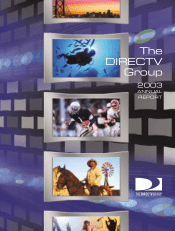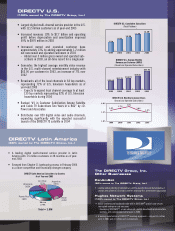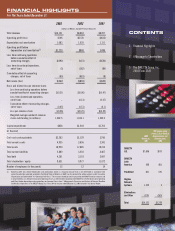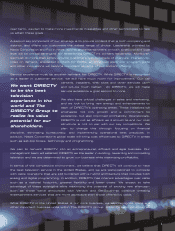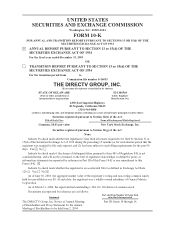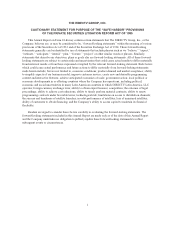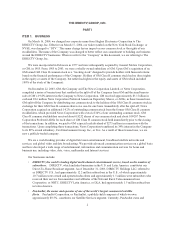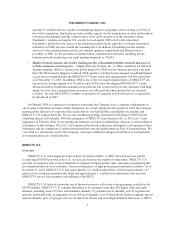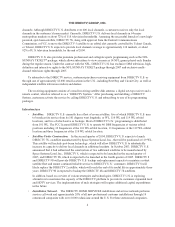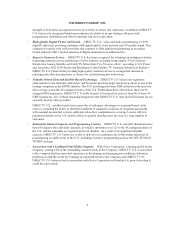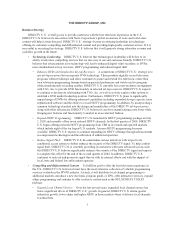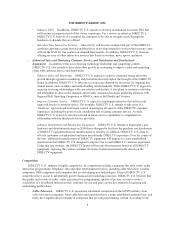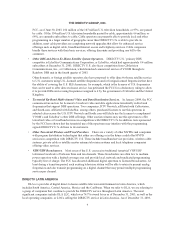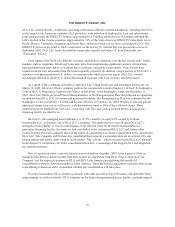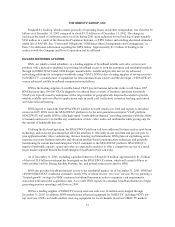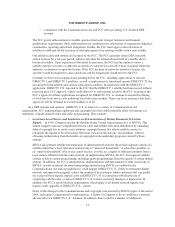DIRECTV 2003 Annual Report Download - page 11
Download and view the complete annual report
Please find page 11 of the 2003 DIRECTV annual report below. You can navigate through the pages in the report by either clicking on the pages listed below, or by using the keyword search tool below to find specific information within the annual report.THE DIRECTV GROUP, INC.
channels. Although DIRECTV U.S. distributes over 600 local channels, a customer receives only the local
channels in the customer’s home market. Currently, DIRECTV U.S. delivers local channels in 64 major
metropolitan markets or about 72% of U.S. television households. Assuming the successful launch of a new high-
powered, spot-beam satellite, DIRECTV 7S, along with approval from the Federal Communications
Commission, or FCC, to move the DIRECTV 5 satellite to an orbital slot currently controlled by Telesat Canada,
or Telesat, DIRECTV U.S. expects to provide local channel coverage to approximately 130 markets, or about
92% of U.S. television households, by the end of 2004.
DIRECTV U.S. also provides premium professional and collegiate sports programming such as the NFL
SUNDAY TICKET™package, which allows subscribers to view as many as 14 NFL games played each Sunday
during the regular season. Under the contract with the NFL, DIRECTV U.S. has exclusive DBS television, high-
definition and interactive rights to the NFL SUNDAY TICKET package through 2007 and exclusive multi-
channel television rights through 2005.
To subscribe to the DIRECTV service, customers purchase receiving equipment from DIRECTV U.S. or
through one of approximately 18,000 retail locations in the U.S., including Best Buy and Circuit City, as well as
independent satellite television retailers and dealers.
The receiving equipment consists of a small receiving satellite dish antenna, a digital set-top receiver and a
remote control, which is referred to as a “DIRECTV System.” After purchasing and installing a DIRECTV
System, customers activate the service by calling DIRECTV U.S. and subscribing to one of its programming
packages.
Infrastructure
•Satellites. DIRECTV U.S. currently has a fleet of seven satellites, five of which DIRECTV U.S. uses
to broadcast its service from its 101 degrees west longitude, or WL, 110 WL and 119 WL orbital
locations, and two of which serve as backups. Most of DIRECTV U.S.’ programming is distributed
from 101 WL. The FCC licensed DIRECTV U.S. to operate 46 DBS frequencies at various orbital
positions including 32 frequencies at the 101 WL orbital location, 11 frequencies at the 119 WL orbital
location and three frequencies at the 110 WL orbital location.
•Satellites Under Construction. In the second quarter of 2004, DIRECTV U.S. expects to launch
DIRECTV 7S, a satellite manufactured by Space Systems/Loral, Inc., that will be positioned at 119 WL.
This satellite will include spot-beam technology, which will allow DIRECTV U.S. to substantially
increase its capacity to deliver local channels in additional markets. In October 2003, DIRECTV U.S.
announced that it had authorized the construction of two additional satellites to be manufactured by
Space Systems/Loral, Inc., DIRECTV 8, which is expected to be launched in the second quarter of
2005, and DIRECTV 9S, which is expected to be launched in the fourth quarter of 2005. DIRECTV 8
and DIRECTV 9S will provide DIRECTV U.S. backup and replacement capacity to maintain a robust
satellite fleet and ensure continued reliable service to DIRECTV U.S.’ customers. DIRECTV 8 will
likely replace the DIRECTV 2 satellite, which will reach the end of its useful life in approximately three
years. DIRECTV 9S is expected to backup the DIRECTV 4S and DIRECTV 7S satellites.
In addition, based on a review of various strategies and technologies, DIRECTV U.S. is exploring
alternatives to maximize the capacity of the DIRECTV platform to provide its customers expanded local
and HDTV services. The implementation of such strategies will require additional capital expenditures
in the future.
•Installation Network. The DIRECTV HOME SERVICES installation and service network performs
service call work and approximately 20% of all new professional customer installations through 14
outsourced companies with over 6,000 technicians around the U.S. For these outsourced companies,
4

